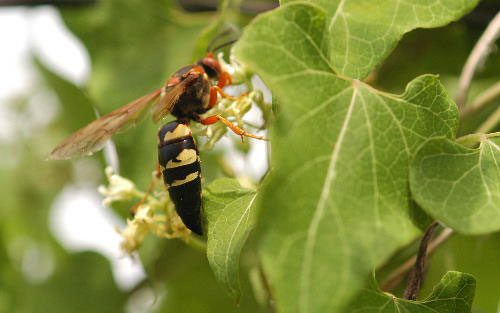
With its red wings and legs, and black abdomen, the cicada killer wasp can look both intimidating and brilliant. (Photo courtesy of Cynthia Domenghini, K-State Department of Horticulture and Natural Resources) | Download this photo
Killer wasps? Only the cicadas need to worry
K-State horticulture expert says common wasp causes little damage to landscapes
Aug. 3, 2023
By Maddy Rohr, K-State Research and Extension news service
MANHATTAN, Kan. — They may look brilliant to the human eye, but cicada killer wasps are certainly no ally to the six-legged, three-eyed insect whose steady buzz can be heard on most summer nights in Kansas.
Kansas State University horticulture expert Cynthia Domenghini said it is common for cicada killer wasps to build nests in lawn and garden areas around the home,
“At about one and a half inches long, cicada killers are an intimidating wasp. They have reddish colored wings and legs and a black abdomen with wide, yellow stripes,” Domenghini said.
Females have a stinger which is used to paralyze their prey. Domenghini said they rarely sting people unless agitated. Males are smaller and do not have a stinger.
“Females are responsible for locating cicadas and paralyzing them with their stinger. She then carries the cicada back to her burrow. Each burrow can house up to 20 cicadas,” Domenghini said.
There is one generation per year of cicada killers, beginning with larvae hatching. Adult cicada killers are most abundant during June and July, then die in early fall.
“Cicada killers typically cause very little damage to the landscape. A heavy infestation may become a nuisance as they protect their nests, and the burrows may be considered unsightly, especially in a lawn area,” Domenghini said.
Cicada killers prefer well-drained, light soils in full sun, she added.
“They may burrow along sidewalks or flowerbeds but do not like areas covered with mulch,” Domenghini said. “Maintaining a thick, healthy lawn is the best control for preventing burrows.”
Domenghini warns that pesticides are not usually necessary since adults are only present for about two months beginning mid- to late summer, but Permethrin may be used for control.
Domenghini and her colleagues in K-State's Department of Horticulture and Natural Resources produce a weekly Horticulture Newsletter with tips for maintaining home landscapes and gardens. The newsletter is available to view online or can be delivered by email each week.
Interested persons can also send their garden and yard-related questions to
Domenghini at cdom@ksu.edu, or contact your local K-State Research and Extension office.

